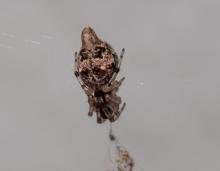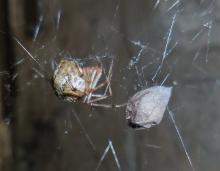Land Invertebrates
Media

Species Types
Scientific Name
Cyclosa conica and C. turbinata
Description
Trashline orbweavers decorate their small, circular webs with an unimpressive line of insect husks and other debris. The small orbweaver rests at the hub within this line of garbage, looking like just another bit of trash.
Media

Species Types
Scientific Name
Parasteatoda tepidariorum (syn. Achaeranea tepidariorum)
Description
You probably have at least a few common house spiders in your garage. Take heart: they are harmless and they eat many pest insects.
Media

Species Types
Scientific Name
Pholcus, Psilochorus, and others in the Pholcid family
Description
Cellar spiders look wispy with their incredibly long, thin legs and habit of bouncing rapidly in their cobwebs when disturbed, which turns them into a blur. Some species are very common in homes.
See Also



Media

Species Types
Scientific Name
Cisseps fulvicollis
Description
The yellow-collared scape moth is more often “orange-collared.” And whether you think it looks more like a firefly or a wasp, it’s still a moth!
Media

Species Types
Scientific Name
Nearly 150 species in North America north of Mexico
Description
Slim, delicate plume moths are instantly recognizable by their T-shaped silhouette, long legs, and muted shades of tan and brown. It can be hard to separate the various species.
Media

Species Types
Scientific Name
Pyrrharctia isabella
Description
Not many people know the adult Isabella tiger moth when they see one, but we’re all acquainted with its caterpillar, the woolly worm, or woolly bear.
About Land Invertebrates in Missouri
Invertebrates are animals without backbones, including earthworms, slugs, snails, and arthropods. Arthropods—invertebrates with “jointed legs” — are a group of invertebrates that includes crayfish, shrimp, millipedes, centipedes, mites, spiders, and insects. There may be as many as 10 million species of insects alive on earth today, and they probably constitute more than 90 percent all animal species.





















